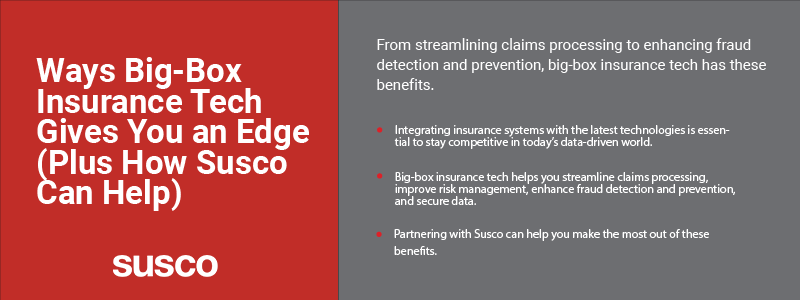From streamlining claims processing to enhancing fraud detection and prevention, big-box insurance tech has four benefits.

Since the era of mainframe computers, the insurance industry has always responded to technological transformation with new products, new ways to evaluate risk, and new distribution methods to stay competitive.
Today, data is king, and big-box insurance tech is driving a new revolution. Traditional insurers must rethink their approach to insurance or risk becoming obsolete. Here’s all you need to know to navigate the rapidly evolving digital landscape:
Understanding big-box insurance tech
Big-box insurance tech involves harnessing technology to enhance and streamline insurance operations like claims processing, risk assessment, and fraud prevention.
This new wave is driven by the need to deliver more accessible, personalized, and customer-centric insurance solutions. It leverages technologies like artificial intelligence (AI), machine learning (ML), and data science to provide greater value to insurers and policyholders.
Here are three ways big-box insurance tech is transforming the insurance landscape:
1. Streamlining claims processing
Big-box insurance tech leverages automation, putting intricate AI-powered algorithms to work in everything claims-related to help insurers unlock greater operational efficiency and customer satisfaction.
These algorithms can process information precisely and transfer it to relevant systems without discrepancies. They can also assess damage, verify coverage, and approve payments within minutes.
What does this mean for your organization?
As automation takes over the mundane tasks, your workforce can focus on critical aspects of your business strategy and areas where they add the most value. This leads to faster claims resolutions, lower operational expenses, improved employee productivity, higher customer satisfaction, and fewer disputes from policyholders.
2. Improving risk management
In terms of risk management, big-box insurance tech lets you leverage advanced data analytics and predictive modeling techniques to develop accurate forecasts. It enables you to analyze data from a wide range of sources, including historical claims, telematics, IoT devices, and social media activity to find patterns, learn about emerging risks, and better understand the risks associated with individual policyholders.
This granular risk assessment allows accurate pricing of premiums based on individuals’ actual risk profiles and better anticipate and mitigate risks.
Embracing these innovations isn’t just a strategic choice; it’s necessary to stay competitive and provide superior service to policyholders. However, access to quality data can be a significant impediment when implementing advanced risk management technologies – especially if your insurance firm runs on legacy infrastructure.
Leading digital solutions providers like Susco can aid your legacy system conversion, helping you extract data from outdated systems and turn them into usable assets. As a result, you’ll be better positioned to harness data insights, leverage modern technology, embrace predictive analytics, and confidently navigate the rapidly evolving risk landscape.
3. Enhancing fraud detection and prevention
Beyond streamlining claims processing and risk management, insurance technology can enhance fraud detection and prevention, helping you stay a step ahead of threat actors.
For example, ML algorithms allow you to process vast datasets and instantly detect fraudulent activities. When a policyholder submits a claim, these algorithms can assess its legitimacy by cross-referencing it with historical data, making it easier to discover anomalies and unmask potential fraudsters.
Big data analytics also plays a crucial role in combating fraud in the digital age. It enables you to dive deep into large, complex data sets where fraud patterns hide to uncover hidden connections and trends.
Consider this example: A person submits multiple claims from various locations within a short timeframe. To a human, this might not immediately raise suspicion. However, big data analytics can flag this as a potential fraud pattern by correlating timestamps, locations, and policyholder information across thousands of claims.
Improving data security and privacy
Bad actors are always looking for ways to access the vast troves of data in the insurance industry to sell or use to target more victims. If your insurance adjusting firm handles more than 10,000 claims a year, it’s likely that you’re a top target for cybercriminals.
A breach can have serious ramifications including sanctions and fines from insurance regulators, financial loss from paying ransoms, and reputational damage.
The best way to stay ahead of hackers is to get proactive with technology. Deploying modern insurance technology can help you highlight threat vectors, encrypt customer data, and make it harder for cybercriminals to compromise your organization.
For instance, converting legacy systems can bolster data security and privacy by enabling the implementation of modern encryption, authentication, and access control measures. It also your organization to stay current with security patches and compliance requirements, reducing the risk of data breaches and legal penalties.
How traditional insurers can compete in the digital space
One of the most effective strategies to navigate the digital age is collaboration – partnering with InsurTech firms to leverage their knowledge and expertise. These tech-driven companies can help you integrate cutting-edge technology into your operations without reinventing the wheel or investing in additional training.
Get the most out of insurance technology with Susco
Make no mistake, the future of insurance is digital. As you navigate this new era, remember that the power to stay ahead is within reach, and it begins with a commitment to embracing digital solutions. Having a reliable and experienced partner lead the way can be highly beneficial. That’s where Susco comes in.
One of our top goals is to help insurance companies improve their business efficiency and boost employee productivity by replacing outdated systems with the latest tools and technologies. We take the time to understand our clients’ goals and deliver the best custom solutions for their needs.
Ready to partner with us? Get in touch with our experts to learn about the next steps in your digital transformation.